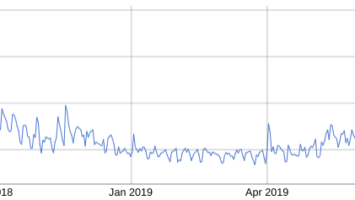Over the course of the past few years, the cryptocurrency mining sector has started to gain a lot of mainstream financial traction. For example, market research firm Technavio recently released startling data claiming that the global mining hardware market is all set to grow by a whopping $2.8 billion between 2020 and 2024. This incredible surge was attributed to the rising popularity of mining pools, most of which are currently concentrated in China.
Not only that, over the course of the past few months, companies like Btc.top have been seeking to redefine the concept of Bitcoin (BTC) acquisition, for example, via the use of a technology called “joint mining,” wherein users can mine crypto remotely by buying a certain amount of hash power from a third-party player. According to Btc.top, the new technology will help mitigate many of the risks that are currently associated with popular cloud mining products by allowing users to have more financial as well as operational flexibility.
Commenting on the matter, Jiang Zhuoer, the CEO of Btc.top, told Cointelegraph that the company will make it easier for individuals and institutional clients to participate in cryptocurrency mining due to the firm’s “infrastructure, strategic industry partnerships and low electricity rates.”
The concept of joint mining is not entirely new
Even though Btc.top’s use of joint mining is being hailed as a significant step forward for the crypto mining sector, it’s worth pointing out that many local mining farms and companies in China have already been using of this business model. One of the major advantages of using this service framework is that electricity can be sourced at cheaper prices. Moreover, profits depend on the ASIC model and farms’ efficiency — while the underpinned revenue lever being risk and profit-sharing. Commenting on the subject, Thomas Heller, the global business director at F2Pool mining pool, told Cointelegraph:
“Many of these kinds of mining farms are located in the Sichuan region of China, which has an abundant hydroelectric power source. But one downside is that Sichuan is prone to many natural disasters such as earthquakes and floods.”
Furthermore, it is worth noting that Btc.top is currently charging around $0.033 per kilowatt-hour to its users for facilitating their mining operations. However, it seems as though electricity costs can keep fluctuating substantially during the rainy season in Sichuan — a locked province in Southwest China where the company has its farms. This is important because users are billed for the electricity their equipment consumes throughout the duration of the entire program per a predetermined contract. So, in reality, even though this model appears lucrative due to lower electricity prices, such inconsistencies are always present for any miner operating in this region.
Addressing the aforementioned concerns, Zhuoer stated that his firm launched its mining service within China in March, long before the electricity rates were lowered by the rainy season. Not only that, but he also added that most of Btc.top’s clients in China are large-scale miners who already enjoy the benefits of subsidized energy rates, adding: “After the rainy season ends, which would likely be in October, these rates would likely be where they were in March, which is already among the lowest for even industrial-scale miners.”
China’s market dominance to continue?
It seems unlikely that China will lose any of its current dominance — in terms of hash rate — at least for the next few months due to the ongoing wet season in Sichuan. Although the United States, and especially Texas, has been seeing a large growth in its existing mining infrastructure, Heller does not expect the same speed and ease of growth that has been achieved in China. However, once the hydro season ends, some miners will move from China to the U.S., Kazakhstan and the Middle East where electricity prices are cheaper.
However, Ditar Bekbauov, founder of mining power marketplace Xive, added that recently, an increasing number of traditional investors are beginning to enter the mining domain via countries like the U.S., Canada, Russia and Kazakhstan. In his opinion: “The only way anyone can compete with China in the next five years is in the software and service niche. Hardware is out of the question.”
A similar outlook is shared by Andrej P. Skraba, the chief marketing officer of NiceHash — a cryptocurrency hash power broker — who told Cointelegraph that China will most likely remain one of the mining superpowers of the world, however, adding that: “We will see more miners shifting to the United States, Canada and ex-soviet states with cheaper electricity rates. The equation is straightforward: If a country or an area can provide cheap power, miners will flock there. Efficiency is the name of the game here.”
PoS is appealing but needs polishing
Simply put, the proof-of-stake mining model allows users to validate block transactions in accordance with the total number of coins they hold. What this essentially means is that the more tokens a miner holds, the more mining power they will have. Even though on paper the aforementioned setup seems quite attractive, Bekbauov pointed out that PoS-based networks are still in their infancy and need some work before they can be fully trusted, at least from a security standpoint. He added:
“We are still not sure how PoS will perform and whether different projects will follow the initial rules of blockchain immutability. We don’t know how secure POS projects are, so in case of hacking, whether validators and stakers will change the blockchain or not. I am confident that in the future, both PoW and PoS will exist.”
The sentiment was echoed by Igor Runets, the CEO and founder of BitRiver — the largest Bitcoin mining operation in Russia — who believes that PoS networks still need to be tested, especially in regard to real-world use cases, adding:
“I believe that some of the concerns around centralization of the PoW model that the PoS model originally aimed at solving remain the same in both models, and it is only a matter of time and adoption before PoS networks face the exact same concerns.”
Moreover, liquidity mining — a community-based, data-driven approach wherein a token issuer or exchange has the ability to reward a pool of miners to provide liquidity for a specified token — has seemingly been gaining traction across a whole host of PoS blockchains, such as Terra, Cosmos, etc.
The mining industry has transformed, but the future is still uncertain
Even though competition within the global mining sector has increased substantially since 2017, following Bitcoin’s most recent reward halving event, the flagship crypto’s native hash rate quotient surged to an all-time high, resulting in BTCs mining difficulty hitting a record high of 17.3 trillion. Heller opined on the competitive aspect of the mining industry:
“Many older generations of ASIC miners have been flushed out of the system, and a new generation of machines have taken over. We are reaching all-time high hash rate and difficulty levels. Currently, daily mining revenue is only $ 0.08 per TH.”
However, fears still continue to plague the industry since legislators and regulators’ actions remain to be an unforeseen variable. For example, earlier in July, Venezuela unexpectedly announced a ban on crypto mining activities emanating from all state-owned housing.
Therefore, just like with exchanges and other cryptocurrency products and services that are subject to various anti-fraud policies, it seems as though mining will also most likely become regulated in the coming years. Skraba added: “It is essential for the industry to find ways for this lucrative market to grow more open and transparent.”




Comments (No)